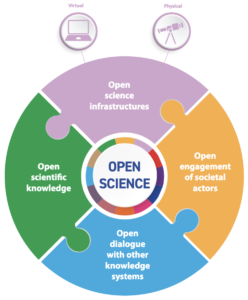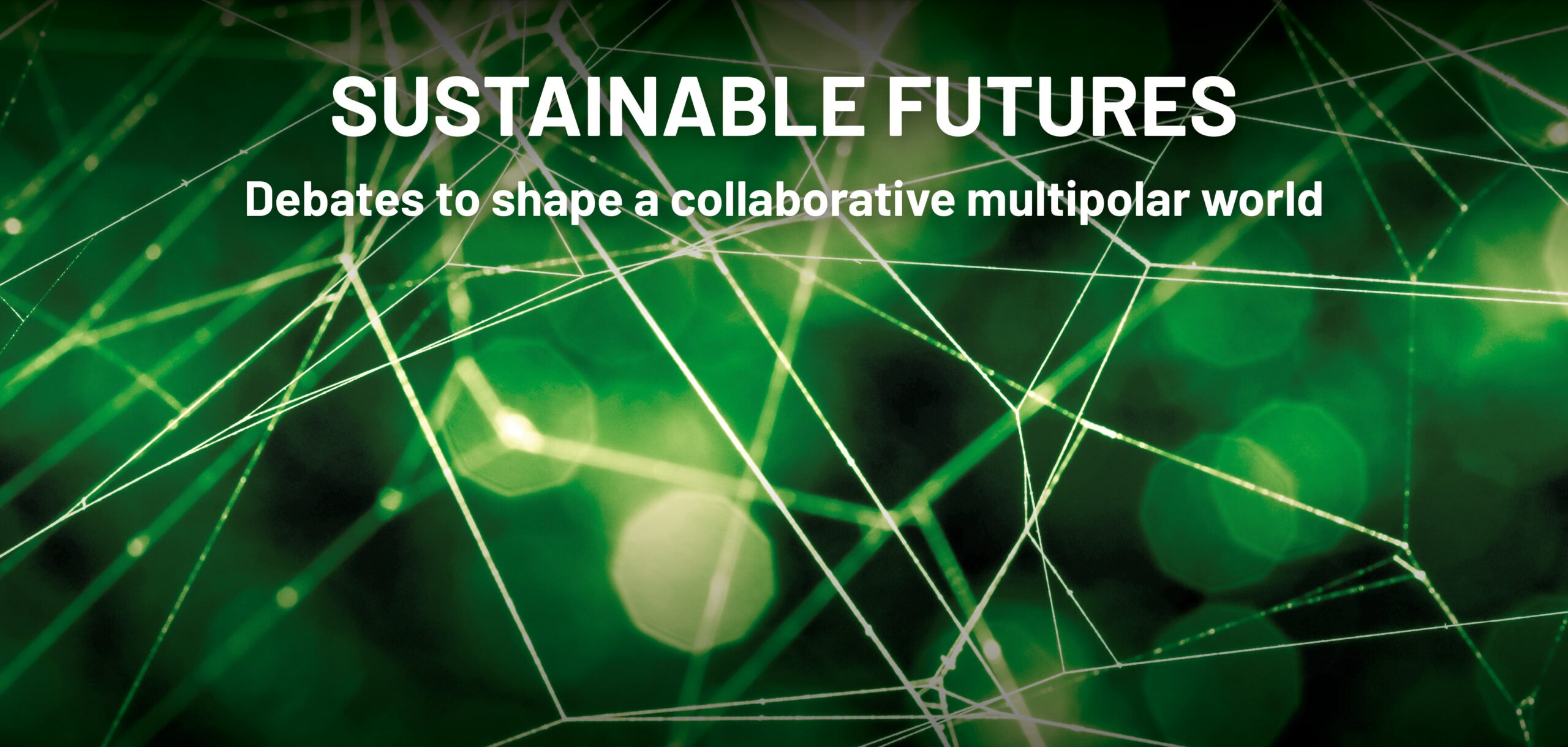 Photo by Pexels on Pixabay
Photo by Pexels on Pixabay
Knowledge cooperation—specifically science cooperation—is a precondition of coordinated efforts for combatting global crises from climate to finance, and from food to public health. Cloud server storage and satellite-based internet connectivity are key technologies to reducing to zero the time and distance necessary to exchange knowledge across the planet. Science could be an effective means of international cooperation towards combatting global crises, but knowledge is currently not shared freely. Consequently, calls for scientific knowledge to be freely accessible and open to participation by everyone are ever more present.
“Open Science”, the term under which the discussion is led, comes with enormous potential to address global challenges such as climate change or pandemics. It has been embraced by international organisations and major science associations around the world. Most recently, in February 2023, the UN’s 3rd Open Science conference, uniting UN bodies with international science institutions and associations made a clear statement: Open Science is necessary for achieving the Sustainable Development Goals, and further, it is an instigator of positive digitalisation in the combat against global crises. Despite these promises, its implementation remains limited. The current science paradigm, political will, technical limitations, and a narrow understanding of the concept constitute key obstacles. Following our previous calls for Open Science action, we identify that G20 countries can build upon initiatives by UNESCO and the EU to implement Open Science and materialise its impact soon.
The Open Science concept benefits from technological advances, as it calls for scientific knowledge to be freely accessible and open to participation by everyone. Its most popular tenets are Open Access, Open Data, and Open Source software, which seek to make publications, data and software code as findable, accessible, interoperable and reusable (FAIR) as possible. The practice of public participation and collaboration in research (citizen science), incorporation of indigenous knowledge, open educational resources, open notebooks, preprints and transparent peer review processes are all aspects of Open Science too.
The current science paradigm
A main obstacle to the full implementation of the Open Science objectives is the current science paradigm, which enforces stratified and hierarchical access to scientific knowledge by creating barriers between citizens and the channels through which knowledge is accessed. Many of those barriers are capital and affiliation-based, with most scientific publications locked behind paywalls, including Article Processing Charges (APCs). The UNESCO Science Report 2021 notes that “five commercial publishers are responsible for more than 50% of all published articles and about 70% of scientific publications are still unavailable in open access.” Other ‘rights to access’ are restricted by intellectual property rights (IPR) regimes, in which private companies and individuals have ownership over the data and production of scientific research. In the name of innovation and economic incentives, IPR are vociferously protected by commercially-driven governance regimes, including private sector lobbyists. The production of COVID-19 vaccines provides an illustrative example of how privatising innovation can conflict with the global common good.
In its Recommendation on Open Science, published in November 2021, UNESCO called for policy implementation at the national and regional levels in order to transform the way that science is conducted and thought about in each UN member state. The Recommendation called for a paradigm shift away from the institutionalisation of science as a tool for profit (or war), and towards the tenet of Article 27 of the Declaration on Human Rights, which defines science as a public good for the common good.
Digital technologies are key instruments for implementing a global Open Science platform, as most scientific knowledge is shared via the internet. However, ubiquitous and open access to scientific knowledge requires that each person has access to the internet, the digital tools which provide the access, and the skills to navigate the online world (digital literacy). Digital technologies are not only an adult tool—they enter the hands of the youngest generations. This means that digital literacy education needs to integrated alongside of ‘traditional’ literacy education of reading and writing. Therefore, the UNESCO Recommendation declares that governments and international institutions need to invest public finances in education, science and digital infrastructure. These public investments are intended to make a clear statement that the right to science and access to the internet are fundamental human rights; they are essential for inclusion and equality, for economic growth and cooperation, for an informed and democratic citizenry, and for connecting humanity to a global pool of knowledge for social advancement and combatting global crises.
Open Research Europe

Despite remaining problems of connectivity and access, and the tenacity of the “closed” science paradigm, Open Science is gaining traction. The European Commission’s Open Research Europe platform is a model for implementing Open Science policies cross-nationally. Open Research Europe is the European Union’s one-stop-shop for its Horizon 2020 and Horizon Europe research funding programmes. It is not only a repository for publications and their datasets, like Zenodo, but it is also a collection of journals, a transparent peer review platform, and a publishing house all in one platform. Metadata from all uploaded materials is organised in an index which makes preprints, publications and datasets as FAIR as possible. Horizon 2020 and Horizon Europe research is publicly funded; and whereas Horizon 2020 piloted Open Science policies in an optional Open Research Data Pilot (ORDP), Horizon Europe mandates Open Science policies in the grants that it awards.
Open Research Europe is primarily a European initiative, and it comes with a global dimension. The EU’s research programmes, such as the Marie Skłodowska Curie Action (MSCA) incentivise scientific partnerships between European research institutions and global partners. Such endeavours can practically promote the practice of Open Science. To illustrate with an example from our institute, the German Institute of Development and Sustainability (IDOS) and Instituto Mora, one of Mexico’s leading research institutions, co-coordinate the MSCA-RISE project, Promoting Research on Digitalisation in Emerging Powers and Europe Towards Sustainable Development. It is an example of the power of network cooperation in the nascency of the European Commission’s Open Science model, and also a case for understanding the barriers and differentiated implementation of Open Science policies per region.
Whereas Open Research Europe can be understood as a model and part of the solution, it is limited to the research conducted under the European Union’s public financing regime. This regime (Horizon 2020, Horizon Europe, etc.) is, not exclusively but, predominantly focused on research by European institutions. We need an ‘Open Research Global’ approach, which not only takes on the roles of being a host of journals, a publishing house, a data repository and a knowledge index, but also acts as a research and innovation investment instrument that incentivises cross-border flows of knowledge and knowledge cooperation in all dimensions. UNESCO is uniquely situated to spearhead an Open Research Global platform. UNESCO cannot pass a policy for the creation of a global and equitable digital infrastructure, but it can establish scientific partnerships between public and private research institutes which incentivize the construction of an adequate digital infrastructure intra- and internationally.
What can the G20 do?
Here the Group of 20 can make a significant contribution. According to a 2020 report from Clarivate’s Institute for Scientific Information, G20 countries accounted for 86% of global research papers in the Web of Science index in 2019. This position comes with the power to promote a global science community in line with the Open Science ideals. The G20 should therefore support initiatives spearheaded by UNESCO and other relevant international bodies in establishing an Open Research Global platform, for sharing scientific knowledge globally and increasing international and economic cooperation. The group could answer the call of the S20 (Science outreach group of the G20), which led up to the last G20 Summit in Bali, Indonesia in 2022, that “G20 governments [should] strengthen the nexus between data, research, policy and practice” by making long term investments in scientific research and open science infrastructures. On this basis, the G20 could employ the Open Science concept for achieving the mandates of the UN 2030 Agenda on Sustainable Development by including more voices (and eyes and ears) in science, technology and sustainable development discourses.
When rolling-out Open Science globally with the support of the G20, policy-makers will have to address concerns that are already on the G20 agenda, such as free flow of data, data localisation, and privacy concerns. In an Open Research Global instrument data and research results would be centralised in a global repository and indexed to be accessed in a FAIR manner, while also requiring that the research be stored locally in interconnected national or regional repositories and indexes. Open Research Global could follow data storage models, such as the International Nucleotide Sequence Database Collaboration (INSDC), which exchanges and keeps copies of data between regional servers. This protects the free flow of data in case of an uptick in data nationalism in one nation or region.
A digital Open Science with a focus on sustainable development would mitigate concerns of constricting a nation’s ability to prosper from the data its institutions produce and reinforce the sentiment that knowledge is to be shared, openly and equally. To illustrate, a G20-supported Open Research Global approach could advocate for community building projects. Citizen science and indigenous knowledge could be brought into the mainstream science discourse, creating pathways for schools and coding communities to access and develop open educational resources and open source software. The values and skills of digital citizenship and digital literacy could be embedded into primary and secondary school education. The sustainability orientation could thus promote science as an enterprise through which we all participate, shaping our world towards the solutions for common challenges.
Governments across the world, politically supported by the G20 and in line with the recommendations by international organisations such as UNESCO, need to invest in digital infrastructure, science and education. Reliable internet connections must be thought of as basic, essential infrastructure for enhancing science, education and community building, and for growing the economy. Science must become a public good, open to participation by all citizens in all places. Laws concerning for-profit knowledge protectionism, such as IPR regimes, need to be rewritten so that innovation is fostered by scientific knowledge with a high public impact. Open Science is a concept that should serve as a guiding star to materialise the full potential of inclusive, globally shared knowledge.
This blog is published jointly with the blog Digitalización Inclusiva, hosted by Instituto Mora, related to the PRODIGEES project.





